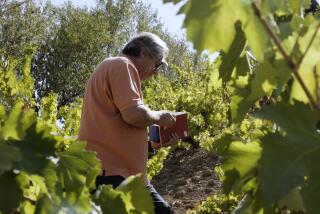How Italian Wine Was Contaminated
- Share via
One of Italy’s major wine producers recently revealed the results of an independent investigation into how unacceptable levels of a chemical contaminant found its way into wines imported to the United States last year.
The study, part of what is certain to be a long-running campaign to regain consumer confidence, was coordinated by scientists from Arthur D. Little Inc. of Cambridge, Mass. The research was prompted after trace amounts of diethylene glycol, a major component in antifreeze, were found in Riunite, which is produced by Cantine Cooperative Riunite of Reggio Emilia.
The research team discovered that the coolant from a refrigerated tank seeped into recently pressed grape juice through a tiny hole. The cooperative repaired the leak and has replaced the diethylene glycol coolant with an ethylene glycol mixture used by U.S. wine makers.
The problems encountered by Riunite resulted in a voluntary recall of more than 1.2 million cases of wine from this country, a figure that amounts to 10% of the company’s total 1985 U.S. sales, the firm reported.
Riunite was not directly implicated in the more recent contamination episode in April when at least eight deaths were linked to low-priced Italian wines adulterated with high levels of methanol. Most of the suspect wines discovered during the scandal were intended for consumption only in Italy, and the resulting deaths and injuries were confined to that country.
None of the methanol-contaminated wine was found in the United States.
Even so, the continuing troubles with contamination have created more than just an image problem for the Italians. Analysts are reporting that U.S. sales of Italian wine were down dramatically, even before widespread news reports of deaths linked to the adulterated wine appeared.
The European Problem--The first imported wines found to contain illegal levels of diethylene glycol were from Austria and surfaced in July, 1985, according to a recent report from the U.S. Bureau of Alcohol, Tobacco and Firearms. The agency has now intensified its laboratory testing for the substance and is regularly monitoring imports for adulterants.
In the meantime, at least 95 different wines from Austria, Germany and Italy have been found to contain unacceptable levels of the contaminant, the bureau reported.
Oh, Henry’s?--A recent beer advertisement in a weekly news magazine contained an unusual acknowledgement of error.
Blitz-Weinhard Brewing Co., makers of Henry Weinhard’s Private Reserve, admitted playing a little loose with facts. In what could be considered an attempt at creating beer lore, a previous Henry Weinhard’s ad claimed that hops, a major component in beer, curls around its vines in a clockwise direction in the Northern Hemisphere, whereas the opposite is true in the Southern Hemisphere.
After running the ad on the directional disparity, the company received letters offering several explanations for this perceived oddity. However, after checking with botanists for an explanation on the issue Blitz-Weinhard discovered that hops do not have a dual personality after all.
“(Hops) grow the same way from Oregon to Australia: Clockwise,” the correction stated. “With reddened faces we apologize for our misinformation and thank those readers who took the time to write.”
More to Read
Eat your way across L.A.
Get our weekly Tasting Notes newsletter for reviews, news and more.
You may occasionally receive promotional content from the Los Angeles Times.










